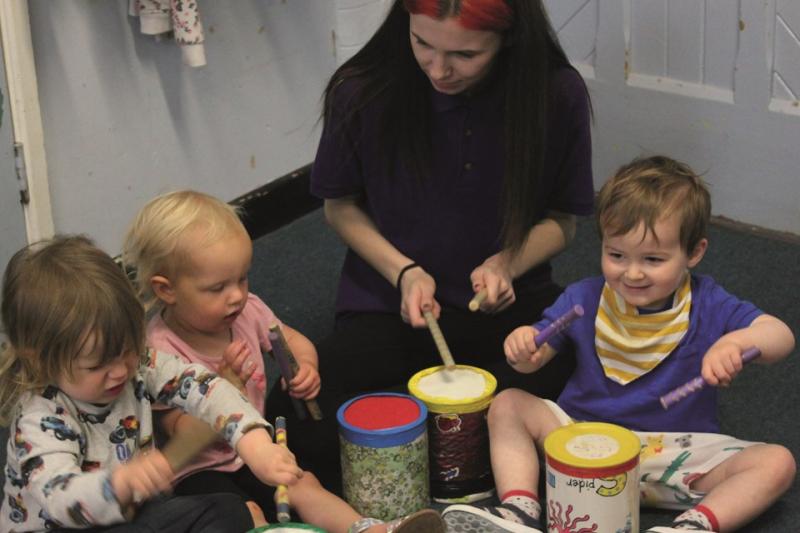Neuro-musical Early Years Evidence

Neuro-musical Early Years Evidence
Neuroscience Evidence
According to neuroscience evidence, exposure to and involvement in regular music making from birth can have significant impact to boost children’s brain development, physical and mental health, and happiness throughout life.
Neuro-musical evidence and Dr Anita Collins
Neuroscientists talk about the musician’s advantage since they are aware that music practice develops neural networks across the whole brain. Dr Anita Collins uses the term neuro-musical evidence and dedicates her work to advocating this evidence for consideration in mainstream education. Following her world-wide tour of labs working in the field of neuro-musical research, in her quest to better understand how music learning impacts brain development throughout life, she wrote a book entitled The Music Advantage. She was amazed at what she learnt about how music listening and music learning at all ages, from day one of life to our final day of life, has the ability to grow, change and repair our brains. She felt that this research had to be shared in a way that every reader, parent, teacher and student could understand the value of regular music experiences, not only for the children taking part but also for the adults.
Music Supporting Language and Literacy Foundations
The brain processes music using the same neural network used for speech and language.
The level of synchronisation that is needed between the auditory, visual and motor cortices of the brain to make sense of the messages (language or music) is tied to the motor circuit which is developed through keeping the beat and rhythmic awareness activities promoted through music practice. This finding indicates a fundamental impact on early years learning for pre-literacy skills.
A research study by Dr Nina Kraus at Northwestern University, Illinois has found biological evidence linking music, rhythmic abilities and language skills – specifically linking the ability to keep a beat to the neural encoding of speech sounds.
The study demonstrates that accurate beat-keeping involves synchronization between the parts of the brain responsible for hearing as well as movement.
“Rhythm is an integral part of both music and language, and the rhythm of spoken language is a crucial cue to understanding. It may be that musical training—with its emphasis on rhythmic skills—can exercise the auditory-system, leading to less neural jitter and stronger sound-to-meaning associations that are so essential to learning to read.” Dr Nina Kraus, Northwestern University
So when you are next marching to a beat or banging a box with a wooden spoon to keep a beat or to work with the rhythm of a piece of music or traditional nursery rhyme, remember that you are developing the key skills needed for language and literacy, and setting fireworks off in the children’s brains– as well as having fun!
You can sign up to download and trial a Boogie Mites tapping and drumming song for FREE here.
Neural Networks
Neuroscientists term the neural network connecting the auditory, visual and motor cortices of the brain, the ‘super sense’. We take information from many sources and this super sense network makes sense of the messages, determining the response. Scientists found that this super sense network was most developed in children who had been practising music regularly for several years. There is also evidence of links with music practice and other neural networks in the brain – that explain the ‘fireworks’ effect of the whole brain activation.
All of the following networks are connected to the 3 main cortices of the brain and all are seen to be activated by music practice:
1. Super sense network – making sense of language
2. Reward network – giving a sense of achievement and motivation, re-enforcing positive learning experiences
3. Cognitive network – the engine room, figuring out how to do things, the steps or process
4. Perceptual network – predicting what comes next
5. Cognition network – figuring out what it all means, what we like or do not like
6. Emotional network – effecting mood, resilience emotions and empathy
Neuro-musical evidence provides us with the understanding of the impact of a rich and varied music provision in the setting on all of the above neural networks – and it is AMAZING!
Boogie Mites Core Music Programmes:
Boogie Mites music activities are informed by the neuroscience evidence and the 3 core programmes will provide everything you need to boost your music provision in the setting for each age group, boosting mood and cognitive development for all involved - staff and children. The online resources include a presentation by Dr Anita Collins so that all the team can value music and movement, with full understand of the incredible benefits:
Boogie Mites School Ready Music Programme (3-5 years)
https://www.boogiemites.co.uk/shop/school-ready-parent-pack/
Boogie Mites Minis Music Programme (2-3 years)
https://www.boogiemites.co.uk/shop/minis-parent-pack/
Boogie Mites Teenies Music Programme (crawlers to 2 years)
https://www.boogiemites.co.uk/shop/teenies-parent-pack/
Boogie Mites are offering a special 20% discount to Morton Michel policyholders as well as a programme launch meeting. Apply the code BMMM20 at the checkout to receive your discount.
Contact sue@boogiemites.co.uk for information about onsite training options.
The information in this article is provided by Boogie Mites and does not represent Morton Michel.